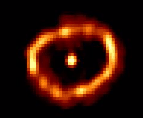V1974 Cyg (Nova Cygni 1992)
V1974 Cyg (Nova Cygni 1992)
 |
| A 1994 Hubble Space Telescope image of the expanding shell of gas expelled by Nova Cygni 1992. Credit: NASA, ESA, HST, F. Paresce, R. |
anything about variable stars
 |
| A 1994 Hubble Space Telescope image of the expanding shell of gas expelled by Nova Cygni 1992. Credit: NASA, ESA, HST, F. Paresce, R. |
The visual discovery of V838 Her by George Alcock of Yaxley, Peterborough, England, on 1991 March 25, 4.35 UT, is a somewhat unlikely story. Having been clouded out, Alcock decided to observe what he could with his 10x50 binoculars from the comfort of inside his home. Every half hour Alcock dilligently looked out through the glass of his window to see what he could (or could not) see with his binoculars.
On December 5th, 1986, nova hunter Mitsuri Suzuki of Ena City, Gifu, Japan, aimed his 200-mm telephoto lens at the Milky Way in northern Andromedae and began a routine exposure in his nova patrol program. Suzuki, a 28-year-old school teacher, had been hunting novae for three years when, on this night, his efforts were finally rewarded.
The slow nova PW Vul was the first of two galactic classical novae that appeared in the constellation Vulpecula in 1984. M. Wakuda of Japan discovered this nova at photovisual magnitude 9.2 on 1984 July 27.7 UT while it was still brightening. The nova reached a visual maximum of 6.3 mag. on 1984 August 4.1 UT. It then began a gradual decline with strong oscillations of one to two mags (Robb & Scarfe 1995).
PU Vul was discovered by Y. Kuwano of Hita, Japan, at photographic magnitude 9.0 on 1979 April 5.83 UT (AAVSO Alert Notices 28, 195).
NQ Vul was discovered visually by the English amateur astronomer George Alcock on 1976 October 21 at a magnitude of 6.5 (AAVSO Alert Notices 9, 10, 12, 13). A precusor to the event was seen on photographic plates taken 26 hours before discovery by the Sternberg State Astronomical Institute in Moscow (Carroll 1977).
The spectacular nova V1500 Cygni burst into the evening sky on August 29, 1975, disrupting the familiar outline of the Northern Cross. Many independent visual discoveries of this magnificent nova were made, particularly Minoru Honda from Kurashiki, Japan, who first discovered the nova at a visual magnitude of 3.0 on August 29th. The nova soared to a peak magnitude of 2.0 the next day, then rapidly faded down 3 mags. in three days, descending a total of 7 mags. in 45 days!
FH Ser was discovered visually on its rise to maximum by Minoru Honda of Kurashiki, Japan, who observed it at visual magnitude 7.0 on 1970 February 13.860 UT . Honda observed it again two days later, and by this time the nova had brightened to magnitude 5.0. By February 18th it reached its visual maximum of approximately 4.4. A few days later the nova began to fade, at first slowly and then more rapidly with an abrupt drop of 4.4 magnitudes in 45 days (7.4 to 11.8 mag. from April 15 to May 30).

Quick Links:
testing
now I will add something to see what happnes.. yay!